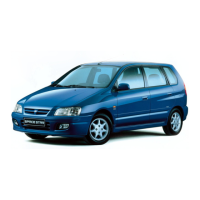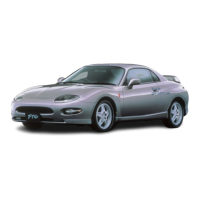The FCM braking function operates at the
following vehicle speed:
l
Against a vehicle: Approximately
5 km/h to 80 km/h
l
Against a pedestrian: Approximately
5 km/h to 65 km/h
CAUTION
l
Do not use the FCM as a normal braking.
l
After your vehicle has stopped following the
activation of the FCM, automatic braking is
released. As the vehicle will then start creep-
ing, be sure to depress the brake pedal to
hold the vehicle stationary.
l
When applying the brake during the auto-
matic braking condition the pedal will feel
firm.
This is not abnormal.
You can apply more pressure to the pedal to
assist in braking.
l
In the following situations, the system pro-
vides neither control nor alarming.
•
When a vehicle or a pedestrian suddenly
cuts in front of your vehicle.
•
When the distance from a vehicle or a pe-
destrian in front is extremely short.
•
To an oncoming vehicle.
CAUTION
•
On vehicles equipped with M/T, when the
gearshift lever is in the “R” (Reverse) po-
sition.
•
On vehicles equipped with CVT, when
the selector lever is in the “P” (PARK) or
“R” (REVERSE) position.
•
When the FCM has detected a problem in
the system.
l
If the ASC is deactivated, the FCM braking
function will not operate. Refer to “Active
Stability Control (ASC)” on page 6-39.
l
The FCM may or may not detect a motorcy-
cle, bicycle or wall depending on the situa-
tion. The FCM is not designed to detect
these objects.
l
The forward collision warning function
and/or the FCM braking function may not
activate in the following situations.
•
When a vehicle suddenly appears just in
front of your vehicle.
•
When a vehicle cuts in front of your vehi-
cle very closely.
•
When the vehicle in front is offset to the
left or right.
•
When the vehicle in front is towing a
trailer.
•
A freight trailer that is not carrying a con-
tainer.
•
The vehicle has a protruding load from
the carrier.
•
The vehicle has a low vehicle height.
•
The vehicle has an extremely high ground
clearance.
•
When a vehicle in front is extremely dirty.
CAUTION
•
When a vehicle in front is covered with
snow.
•
When a vehicle in front has a large glass
surface.
•
When a vehicle in front does not have re-
flectors (lamp reflector) or the position of
the reflector is low.
•
When a vehicle in front is a car carrier or
a similar shaped vehicle.
•
When there is a different object near the
vehicle.
•
When driving on a road with many and
successive curves, including when pass-
ing their entrances and outlets.
•
When accelerating and decelerating
quickly.
•
When the system recognizes driver’s
steering, accelerating, braking or gear
shifting actions as evasive actions to
avoid collision.
•
When you are driving on a road with
steep and alternating up and down slopes.
•
When driving on a slippery road covered
by rain water, snow, ice etc.
•
When a road surface is surging, and there
is unevenness.
•
When driving in dark areas, such as in a
tunnel or at night.
•
When your vehicle changed lanes, and
your vehicle approached immediately be-
hind the vehicle in front.
•
During a certain time after your vehicle
turns left or right.
Forward Collision Mitigation system (FCM)*
6-48
OGAE19E1
Starting and driving
6

